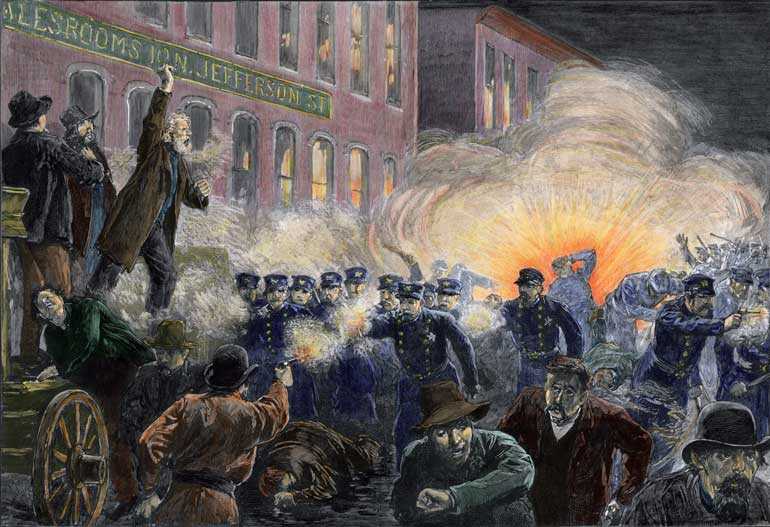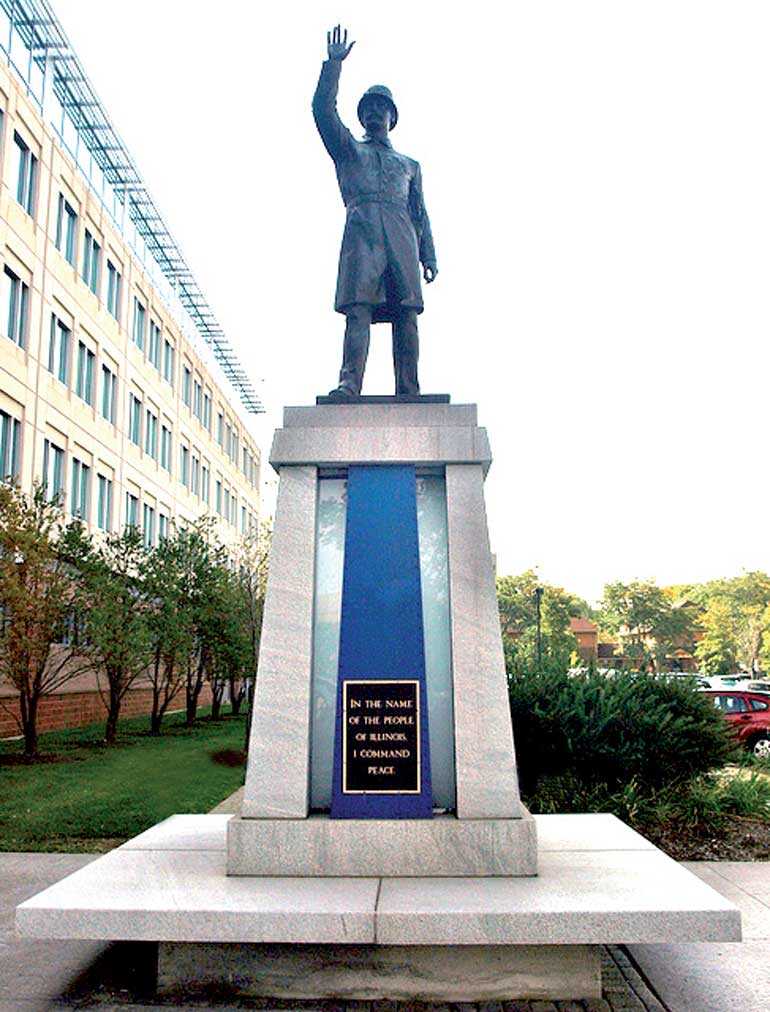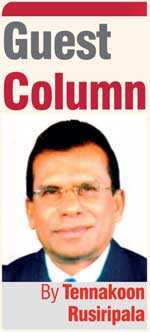Saturday Feb 22, 2025
Saturday Feb 22, 2025
Friday, 1 May 2020 00:00 - - {{hitsCtrl.values.hits}}

No single event has influenced the history of labour as much as the Haymarket affair

Haymarket statue at Michigan Avenue Police Headquarters
Today is World Labour Day, more popularly known as the May Day. World history records it as the day of commemoration for the workers of United States who agitated at the cost of several human lives and with much bloodshed, during the demonstrations and the strike, demanding an eight-hour working day,  starting on 1 May 1886 in the United States, culminating in the famous Haymarket Square Massacre.
starting on 1 May 1886 in the United States, culminating in the famous Haymarket Square Massacre.
No single event has influenced the history of labour in the entire world as much as the Haymarket affair. On this historic day still remaining dedicated to the working class ever since, we recall with great respect those happenings.
The hardships, faced by mostly immigrant workers during the period between 1882 and 1886, led towards an organisational build-up demanding better working conditions. Workers had to toil exceeding 60 hours during a six-day week. The response of the employers was extremely hostile and instead of acceding to the just demands they resorted to anti-union measures such as sacking, discriminating against unionised workers, lockouts, enrolling black-legs, and even employing hooligans and thugs to divide and terrorise the workers.
Targeting 1 May 1886 to be the day for starting an eight-hour day, the organisations campaigned for it from 1984. On Saturday, 1 May 1886, about half a million went into action joining in rallies, demonstrations and went on strike. Nearly 40,000 workers went on a stoppage of work in Chicago. The strike continued and on 3 May a confrontation between non-striking employees with the strikers developed into big brawl. The Police previously summoned by the factory owners to give protection to the strike breakers fired on the crowds, killing two persons.
This Police action caused an outrage which forced the strikers to stage a stronger protest on the following day. With fliers and notices circulated they organised a mammoth rally at the Haymarket Square in the city with the slogan ‘to seek justice against the murder of strikers by the Police’. It was a well-attended rally with over 3,000 workers participating and conducted peacefully, watched by a large Police battalion stationed nearby.
When it was very late in the evening at about 10 p.m., a posse of Policemen suddenly broke in to the meeting place ordering the meeting to be stopped and the workers to disperse. Then a bomb was thrown at the advancing Police party by some unknown person which exploded killing two Policemen and mortally injuring six other officers. Enraged, Police started to fire into the crowds.
The actual number of casualties has not been determined, but the civilian deaths has been estimated to be about eight. Fleeing workers were shot at, causing fatal injuries. The Police deaths as later confirmed by evidence, except for one resulting from the bomb throw, has been due to the indiscriminate Police shooting killing their own officers in the darkness of night.
Eight activists were arrested and a mock trial with handpicked jurors convicted them for murder. On 11 November 1887, after many trials in appeal, three persons were hung to death. One person died by suicide in the prison cell on the night before the hanging. The other four convicted were subsequently pardoned by authorities, publicly condemning the travesties of the infamous judgement.
The people who took leadership in that historic struggle are treated as martyrs of the working class and 1 May as the day of remembrance of the Haymarket Heroes as a day dedicated as the International Workers’ Day. Owing to the people who sacrificed their life and blood, and those who became victims of mock trials to be hanged, and their families burned down to the ground, we enjoy an eight-hour working day with Saturday as a weekend.
Remembering Alexander Ekanayake Gunasinghe
On this day, we will be failing in our duty on behalf of the oppressed and the working class in Sri Lanka (then Ceylon), if we fail to pay our tributes to one of the pioneering trade union leaders popularly known as the “Father of the Labour Movement”. He is none other than Alexander Ekanayake Gunasinghe (1 May 1891-1 August 1967), himself born on May Day. History provided me the great opportunity to be in his shoes for nearly a decade leading the Ceylon Bank Employees’ Union (CBEU) as its President, founded by A.E. Gunasinghe.
He is remembered today as the undisputed leader who spearheaded the country’s trade union movement. His activities were prominent in several fields. He was a social worker, a freedom fighter, a politician turned trade union leader who was accepted as an advocate of the poor.
His political career started with the formation of the Ceylon Labour Party in 1928 associated with several other prominent personalities like C.W.W. Kannangara, George E. de Silva, and C.E. Corea to mention a few. Late President Premadasa too was in the committee.
A.E. Gunasinghe engaged in his public and social activities during a period when the country was under the rule of the British Empire. The colonial background and the oppression the people faced under it made him to rise up as a freedom fighter and a radical who braved all odds with his daring qualities as a courageous leader, fighting for the rights of the workers.
Gunasinghe started his national freedom struggles in association with Anagarika Dharmapala joining his Temperance Movement, soon after he was released from custody, arrested on account of the 1915 riots. He was imprisoned with leaders like D.S. Senanayake, F.R. Senanayake and D.B. Jayatilleke. Two others who were taken into custody with them, C.A. Hewavitharana and Henry Pedris, were shot under military law under fabricated criminal charges.
Gunasinghe along with others fought valiantly against the Colonial Government and stood as a prominent figure revolting against taxes imposed by the British on poor people. Gunasinghe gave leadership to defy those, himself becoming a victim for penalisation under which he was made to break rocks by hand. The monument put up as a memorial in the Gunasinghepura area, later named in his honour, depicts this episode.
Trade union movement in Sri Lanka
Gunasinghe’s involvements in the trade union movement in Sri Lanka marks several milestones. He founded the first trade union, the Ceylon Labour Union, in 1922. A series of defiant struggles led by him succeeded in bringing about great measures of relief to the working population in the country. 
The Government Railway Strike, 1923, succeeded in obtaining a 20% salary increase and casual and sick leave rights. The Harbour Workers’ Strike (1929) was another important strike action initiated by his union and it resulted in a wage increase of 0.25 cts and a lunch break of 15 minutes.
The Tram Workers’ Strike, 1929 was one which sparked off many clashes and troubles. Police harassment of the strikers spread the strike to other sectors of the working class and gave rise to large demonstrations. A clash took place between the Police and the strikers and the Maradana Police Station was set on fire. The unrelenting employers were forced to come to a negotiated settlement after 13 days of strike action.
A significant factor that needs emphasis about the role of A.E. Gunasinghe in the labour movement of the country is that he achieved many good results while the British Government and the leading employers were reluctant to recognise the radicals who controlled the militant urban labour movement. Despite this his union movement was successful in persuading some liberal employers to enter into historic collective agreements incorporating landmark terms and conditions highly beneficial to the workers. This was an indirect acceptance by the British that the articulate group of urban workers, politicised and educated, associated with radical leaders, was a group that should be recognised as a group capable of championing the interests of the workers.
Banking industry
Gunasinghe’s expansion into a country-wide trade union movement culminated with his entry into the banking industry in 1943. Employees in many imperial and colonial banks were unionised under the Ceylon Bank Clerks’ Union formed by A.E. Gunasinghe as its first President. It was registered on 1 September 1944.
During this period bank employees were working under enormous hardships and the colonial masters treated them shabbily. Bank clerks were made to work several hours a day beyond the normal periods without any OT payments. Salaries, increments, promotions and even the superannuation payments were highly discretionary and worst of all discriminatory. Locals were ill-treated in granting promotions and placements.
The unionisation of the banking industry and the militancy that was associated with the movement brought about a marked change not only in the banking industry but served as an impetus to the other sections of the working class in the country. The union was successful in winning many industrial awards of lasting benefits due to the industrial actions which led to the appointment of commissions and industrial arbitrations.
There were several strike actions launched in the banks by the union and they resulted in the employees securing, holidays, overtime payments, superannuation schemes, regular annual increments and equitable promotions, etc. Certain landmark awards such as the Roberts Award 1944, Thambiah Award and the St. Claire Swan Award guaranteed rights and privileges the employers were refusing to grant earlier.
A.E. Gunasinghe’s public role was crowned with his entering into politics. In 1931 he was elected as the first member of the Colombo central electorate and was elected to the Colombo Municipality in 1940. He became the first Ceylonese Mayor of Colombo in 1943. In 1947 he entered Parliament as the first member for the Colombo Central electorate and became a minister in the D.S. Senanayake Cabinet. Later he served as an Ambassador to Burma and Indonesia.
An illustrious and ardent trade union leader
As an ex-bank employee and one-time President of the CBEU, I consider it as a tributary action on my part to bring back the memories of an illustrious and ardent trade union leader who devoted so much of his time and dedication to play a dynamic role and to give a courageous leadership to organise the working class of this country against the oppressive colonial regime on this International Day of the Working Class. There is no doubt that he was an inspiration to the socialist-minded politicians of the later years to take the initiative towards several proactive labour legislations and concessions.
The first May Day was held in Sri Lanka under his leadership in 1927. It is on record that the May Day rally held in 1933 with his leadership was a historic demonstration by the workers of the country then. Men and women clad in red dress outfits marched along the streets from Price Park to Galle Face Green singing working class songs without the shouting of any political slogans in procession with drummers and dancers. No account of the history of May Day in Sri Lanka, however brief it is, could be justified as fair without a reference to some of the notable events and developments associated with it.
The S.W.R.D. Bandaranaike Government of 1956 declared May Day as a Public, Bank and Mercantile Holiday, paving the way for a more officially recognised day with a right for the workers to march and hold rallies espousing their cause. Workers who were mostly organised under the left-oriented political parties and movements celebrated May Day for several years displaying their collective strength, with resolutions being adopted year after year for solving their grievances.
Political party pageants
With the passage of time the May Day celebrations in Sri Lanka took the shape and colour of political party pageants to demonstrate their numbers and the workers soon joined ranks with these parties in effect weakening the workers’ movement. This grew up to a situation where the May Day celebrations became an annual event of the capitalist political parties while those workers who stood on their own to remain independent and fight for the rights of their members got reduced to an insignificant minority compared to the mammoth display of people’s participation at the political rallies.
Many attempts made by interested groups to free the workers from the grip of political parties failed. In the ’90s few leading trade unions not directly affiliated to any political parties came together to rally under a common umbrella organisation which they formed, the National Trade Union Centre (NTUC). The CMU and the CBEU played the lead role in this movement and were able to bring together 17 trade unions covering several important sectors and industries. They were able to hold joint May Day rallies of this grouping for three consecutive years and it is noteworthy to mention that the Ceylon Communist party also joined this independent workers’ rally in one year under comrade M.G. Mendis. Unfortunately due to the ever-prevailing sectarianism among trade unions, this valiant effort initiated and prompted by a few right-thinking individuals was eventually sabotaged.
Historical developments
The historical developments in the labour field such as the formation of the ILO and international trade union apex organisations brought in many desired accomplishments, especially the ILO oriented tri-partite concept was instrumental in bringing in several new legislations resolving many long outstanding issues confronting the workers. The principal of collective agreements has helped to maintain guaranteed industrial peace under amicable resolutions.
Two May Days have been postponed to subsequent days by Executive action warranted due to religious considerations in this country – 1967 May Day got pushed to 2 May and the May Day of 2018 was put off to 7 May that year by a proclamation for the same reason of Vesak Poya falling on 1 May. The tragic event of the bomb blast killing President Premadasa and several others happened on a May Day. I can remember how we had to stop a joint May Day rally that was in progress, we were then holding in the White Park, Maradana.
COVID-19 with no uncertainty has imposed its tyrannous influence on all countries in the world, making the humans succumb to it, with no May Day celebrations this year.
Workers over the world are striving to conceptualise their role “as partners of social progress” and consign the history of violent clashes between labour and capital that the world has experienced to something monumental of the past. The workers are now playing a critical role as they take charge of the digital technology of greater innovation to find lasting and realistic solutions for human problems such as COVID-19.
It is high time we move out of capital and labour conflict and instead work with smart partnership relations.
In conclusion I wish to quote the words one of those Haymarket martyrs pronounced just before the noose tightened round his neck, the day he was hung, now engraved on the monuments built in their honour: “The day will come when our silence will be more powerful than the voices you are throttling today.”
Hail May Day!
(The writer is former President – CBEU.)
Discover Kapruka, the leading online shopping platform in Sri Lanka, where you can conveniently send Gifts and Flowers to your loved ones for any event including Valentine ’s Day. Explore a wide range of popular Shopping Categories on Kapruka, including Toys, Groceries, Electronics, Birthday Cakes, Fruits, Chocolates, Flower Bouquets, Clothing, Watches, Lingerie, Gift Sets and Jewellery. Also if you’re interested in selling with Kapruka, Partner Central by Kapruka is the best solution to start with. Moreover, through Kapruka Global Shop, you can also enjoy the convenience of purchasing products from renowned platforms like Amazon and eBay and have them delivered to Sri Lanka.
Discover Kapruka, the leading online shopping platform in Sri Lanka, where you can conveniently send Gifts and Flowers to your loved ones for any event including Valentine ’s Day. Explore a wide range of popular Shopping Categories on Kapruka, including Toys, Groceries, Electronics, Birthday Cakes, Fruits, Chocolates, Flower Bouquets, Clothing, Watches, Lingerie, Gift Sets and Jewellery. Also if you’re interested in selling with Kapruka, Partner Central by Kapruka is the best solution to start with. Moreover, through Kapruka Global Shop, you can also enjoy the convenience of purchasing products from renowned platforms like Amazon and eBay and have them delivered to Sri Lanka.